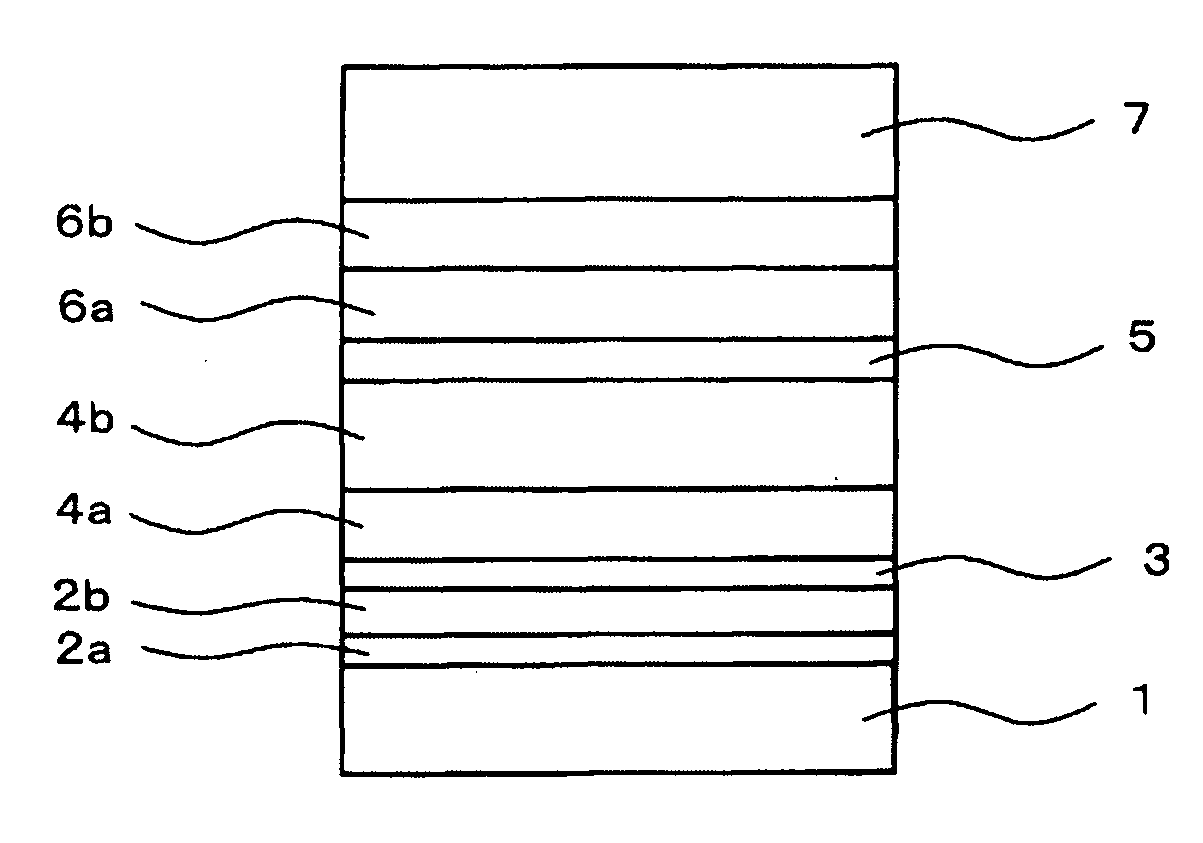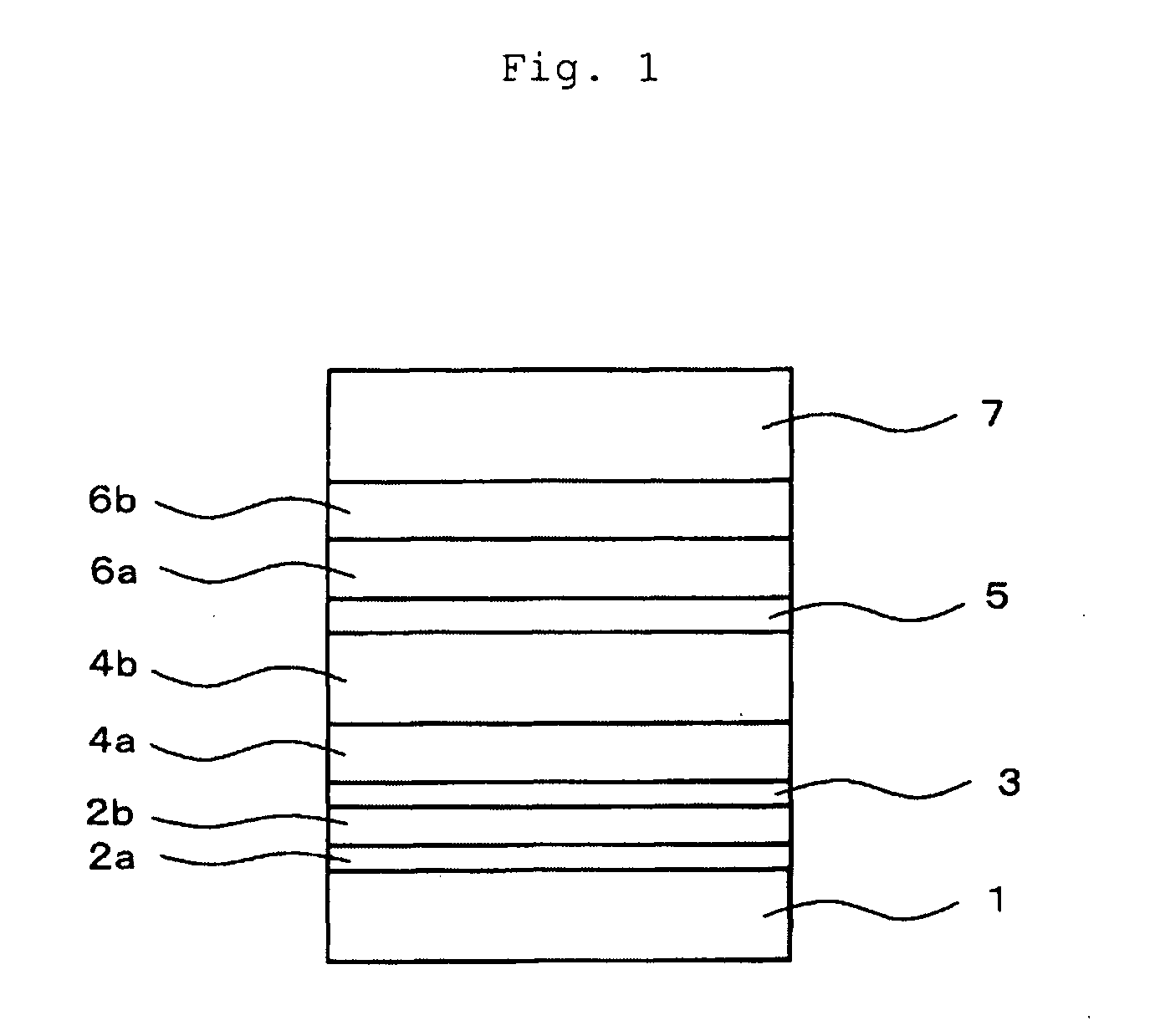Electron transporting materials and organic light-emitting devices therewith
a technology electron transporting materials, which is applied in the direction of discharge tubes/lamp details, organic chemistry, discharge tubes luminescnet screens, etc., can solve the problems of low heat resistance of organic light-emitting devices, high crystallinity, and difficulty in retaining an amorphous thin film, so as to achieve stable thin films and reduce voltage. , the effect of high heat resistan
- Summary
- Abstract
- Description
- Claims
- Application Information
AI Technical Summary
Benefits of technology
Problems solved by technology
Method used
Image
Examples
example 1
Synthesis of DPF
[0106]DPF was synthesized according to the synthesis scheme shown below under the title of Chemical Formula 20.
[0107]First, 12.5 g (75.39 mmol) of fluorene, 21.0 g (173.4 mmol) of 4-cyanofluorobenzene, DMF, and 1.0 g (7.52 mmol) of potassium carbonate were added in this order to a flask and allowed to react under a nitrogen atmosphere at 125° C. for 22 hours.
[0108]The reaction solution was filtrated, and the resulting filtrate was subjected to reprecipitation with methanol. The precipitated crystal was separated by filtration, washed with methanol and dried in a dryer.
[0109]As a result of mass spectrometry (MS) and 1H-NMR analysis, the resulting crystal was identified as the target product, 9,9′-bis(4-cyanophenyl)fluorene. The amount of the product was 12.2 g, and the yield was 43.9% based on the amount of fluorene.
[0110]Thereafter, 5.5 g (14.93 mmol) of the resulting 9,9′-bis(4-cyanophenyl)fluorene and TFT were added to a reaction vessel and stirred under a nitrogen...
example 2
Synthesis of DPF
[0140]DPF was synthesized according to the synthesis scheme shown below under the title of Chemical Formula 21.
[0141]First, 5.0 g (30.08 mmol) of fluorene, 8.4 g (69.18 mmol) of 3-cyanofluorobenzene, 24.5 g (75.2 mmol) of cesium carbonate, and DMF were added in this order to a reaction vessel and allowed to react under a nitrogen atmosphere at 150° C. for 22 hours.
[0142]The reaction solution was filtrated, and DMF was removed. The residue was then purified on a silica gel column developed with a mixed solvent of ethyl acetate / n-hexane.
[0143]As a result of MS and 1H-NMR analysis, the purified product in the form of yellow sticky powder was identified as the target product, 9,9′-bis(3-cyanophenyl)fluorene. The amount of the product was 5.1 g (46.5% yield).
[0144]To a flask was added 70 ml of a 1 mol / l THF solution of methyl magnesium bromide, and the air was replaced by a nitrogen atmosphere. A solution of 5.1 g (14.01 mmol) of the resulting 9,9′-bis(3-cyanophenyl)fluor...
example 3
[0159]An organic light-emitting device having the layered structure shown in FIG. 1 was prepared using the process of Example 1, except that the m-DPF synthesized in Example 2 was used as the electron transporting material.
[0160]Briefly, the layered structure of the device is as follows: ITO (110 nm) / NS21:MoO3 (10 nm, 80:20) / NS21:MoO3 (20 nm, 90:10) / NS21 (5 nm) / NS21:EY52 (20 nm, 98.7:1.3) / EB43:EB52 (30 nm, 98.8:1.2) / m-DPF (20 nm) / m-DPF:Liq (10 nm, 74:26) / Al (100 nm).
PUM
| Property | Measurement | Unit |
|---|---|---|
| Tg | aaaaa | aaaaa |
| melting points | aaaaa | aaaaa |
| melting points | aaaaa | aaaaa |
Abstract
Description
Claims
Application Information
 Login to View More
Login to View More - R&D
- Intellectual Property
- Life Sciences
- Materials
- Tech Scout
- Unparalleled Data Quality
- Higher Quality Content
- 60% Fewer Hallucinations
Browse by: Latest US Patents, China's latest patents, Technical Efficacy Thesaurus, Application Domain, Technology Topic, Popular Technical Reports.
© 2025 PatSnap. All rights reserved.Legal|Privacy policy|Modern Slavery Act Transparency Statement|Sitemap|About US| Contact US: help@patsnap.com



